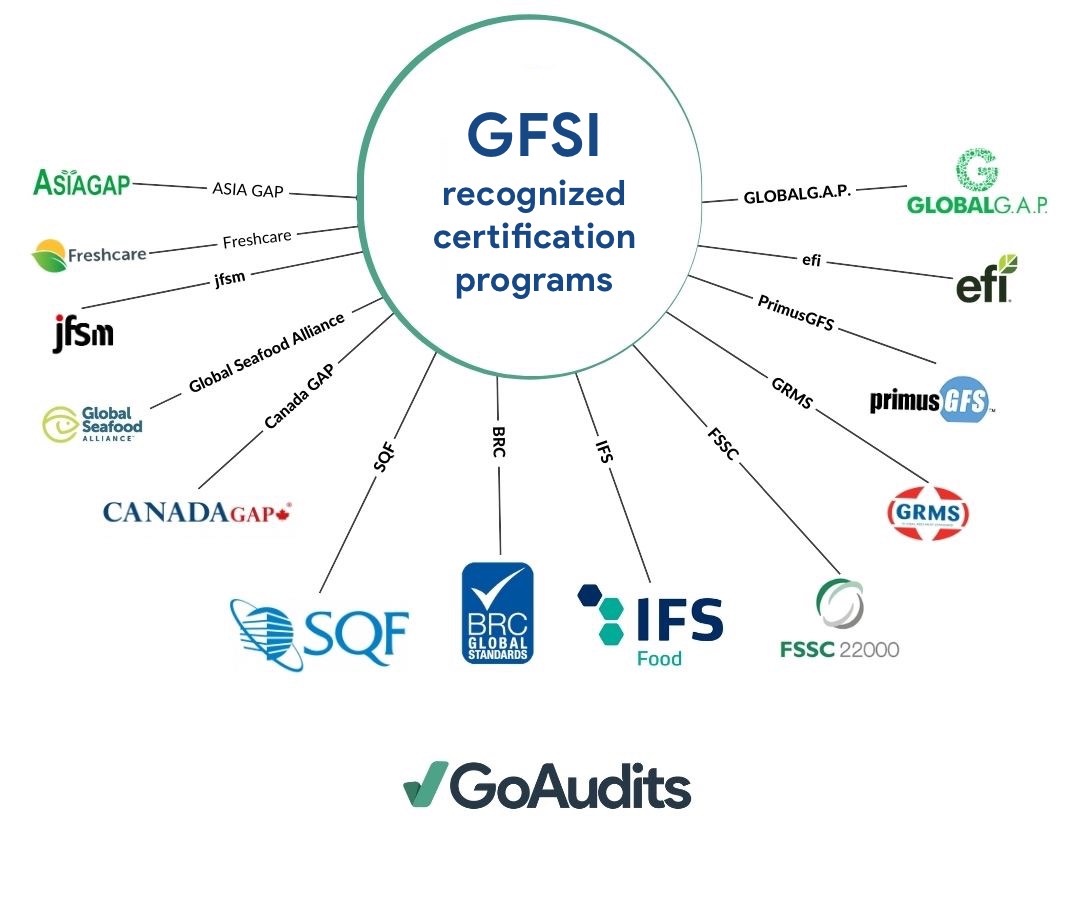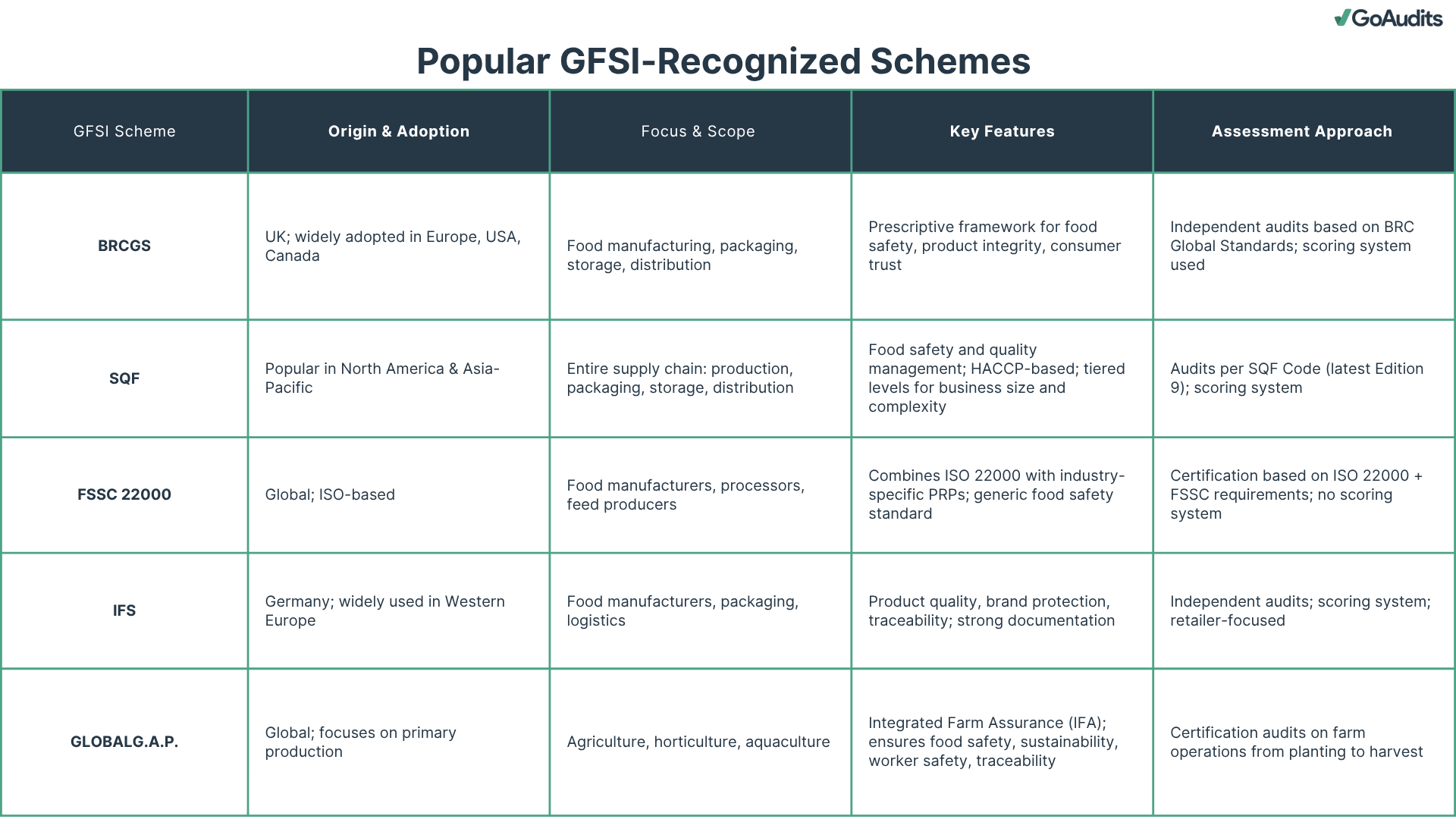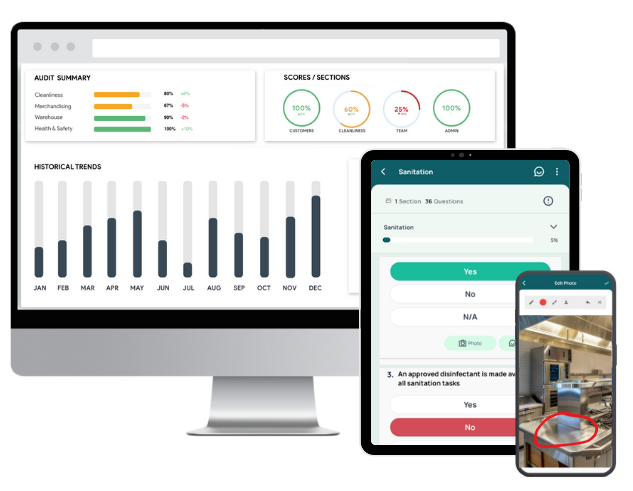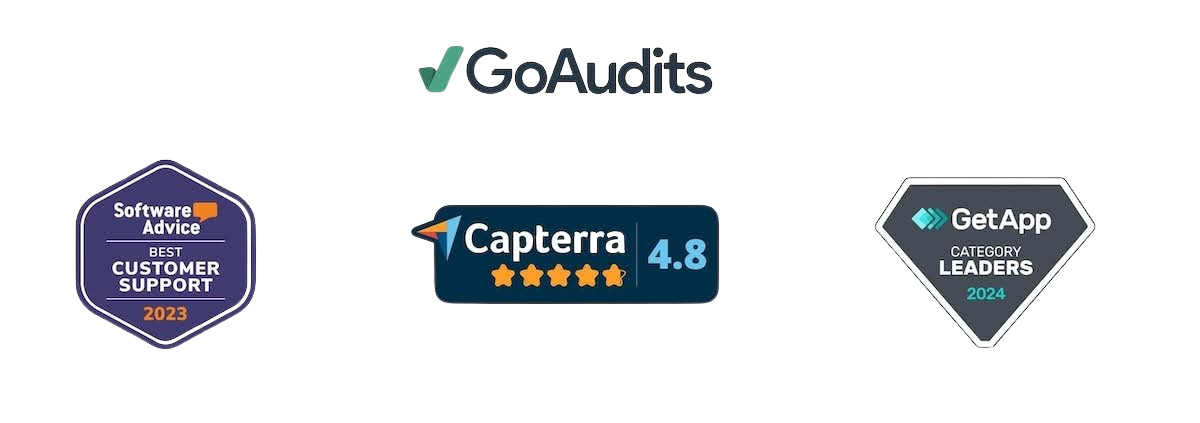The Global Food Safety Initiative (GFSI) is a worldwide collaboration that sets benchmarks for food safety standards. Instead of creating its own standard, GFSI recognizes and approves existing food safety certification programs that meet its rigorous criteria. GFSI compliance means you have implemented robust processes to identify, control, and monitor food safety risks effectively, and your food safety management system aligns with one of the benchmarked certification programs. However, GFSI audits are required to verify compliance. GFSI-recognized certification strengthens consumer confidence and facilitates global market access by meeting the expectations of retailers, manufacturers, and regulators alike.
This article will explore some popular GFSI-recognized schemes, the audit process, certification best practices, free checklists, and more.
- What are GFSI Schemes and Standards?
- What are GFSI Audits?
- GFSI Certification: What It Is & Why It’s Important
- GFSI Audits Process: How to Achieve Certification
- Prepare for GFSI Audits & Certification with GoAudits
- How to Choose the Right GFSI Certification Program For Your Business
- Common Challenges in GFSI Certification & Tips to Avoid Them
- FAQs
What are GFSI Schemes and Standards?
Global Food Safety Initiative (GFSI) benchmarks and recognizes food safety certification programs. It does not issue certificates or carry out audits itself. Instead, it offers certification through a GFSI-recognized scheme. Audits and certifications are conducted by third-party certification bodies accredited to the approved schemes.
This recognition provides a unified framework for food safety across the supply chain. Suppliers, manufacturers, and retailers can operate with a common understanding of safety requirements, enhancing international confidence in certified products.
Below are the most common GFSI-recognized schemes:

British Retail Consortium Global Standards (BRCGS)
BRCGS is widely adopted in Europe and beyond. It covers food manufacturing, packaging, storage, and distribution. BRCGS provides a clear, prescriptive framework to manage food safety, product integrity, and consumer trust.
👉 GoAudits offers free BRC audit checklists. You can sign up for free and start using these checklists to perform internal BRC audits and prepare for certification.
Safe Quality Food (SQF)
SQF is popular in North America and the Asia-Pacific. It combines food safety and quality management across the supply chain. It follows HACCP principles and offers tiered levels to suit businesses of different sizes and complexity.
👉 Free Resources
Use these free checklists to prepare for SQF audits and certification.
→ SQFI Food Manufacturing Audit Checklist
→ SQFI Storage and Distribution Checklist
→ SQFI Quality Checklist
→ SQFI Manufacturing of Food Packaging Checklist
→ HACCP-Based SOP Templates
Food Safety System Certification 22000 (FSSC 22000)
FSSC 22000 is based on ISO standards and applies to food manufacturers, processors, and feed producers globally, integrating ISO 22000 with industry-specific Prerequisite Programs (PRPs).
👉 Additional Resources
International Featured Standards (IFS)
IFS focuses on auditing food manufacturers, packaging, and logistics. It emphasizes product quality, brand protection, and compliance. It’s widely used by European retailers to ensure consistency and reduce supply chain risks.
👉 Use this IFS (Food Standard V8) audit checklist to perform IFS audits and ensure compliance with IFS Food Version 8.
GLOBALG.A.P.
GLOBALG.A.P. sets standards for primary production, including agriculture, aquaculture, and horticulture. Its Integrated Farm Assurance (IFA) standard ensures food safety from planting to harvest while promoting sustainability, worker safety, and traceability. Certification helps producers access global markets and meet retailer requirements.

👉 GoAudits is an all-in-one inspection and audit platform that enables food businesses to efficiently manage compliance with various GFSI-recognized schemes. Conduct internal audits on any device, capture photos for objective evidence, and generate detailed audit reports automatically. Track non-conformities, assign corrective actions, and monitor progress in real time to stay prepared for external certification audits. GoAudits gives you complete visibility and control over your food safety management system, making GFSI audit readiness faster, easier, and more reliable.
What are GFSI Audits?
GFSI audits are third-party food safety assessments conducted against standards that have been recognized and benchmarked by the GFSI. GFSI itself is not a regulatory authority but rather a business-driven initiative established in 2000 by the Consumer Goods Forum to harmonize food safety standards globally.
It operates under the principle of ‘once certified, accepted everywhere’, meaning that certification under any GFSI-recognized scheme should be accepted by retailers and manufacturers worldwide. It benchmarks existing food safety certification programs or schemes rather than creating its own standards.
GFSI audits evaluate three core elements: whether suppliers document what they do (policies and procedures), whether they implement what they document (observing processes and interviewing employees), and whether they track their compliance (reviewing records).
GFSI audits are performance-based and evaluate the entire food safety management system.
Frequency of GFSI Audits
GFSI audits follow specific frequency requirements to maintain certification validity:
- Standard Frequency: All GFSI-recognized schemes require a minimum audit frequency of one audit per year.
- Certificate Validity: Most certifications to a GFSI-recognized scheme are valid for 12 months for facilities receiving grades A or B, requiring annual recertification audits.
- Grade C or D Sites: More frequent audits every 6 months until improvement is demonstrated.
- Special Cases: Storage and distribution facilities handling only consumer products may qualify for 18-month audit cycles in some schemes.
👉 A significant GFSI requirement implemented in 2020 mandates that every facility must have at least one unannounced audit every three years. The unannounced audit requirement applies regardless of audit grade.
Beyond external certification audits, every GFSI-certified site must conduct internal audits annually to maintain compliance.
Cost of GFSI Audits
The cost of GFSI audits varies significantly based on multiple factors, but typical ranges can be established:
| Standard Range | $5,300 to $9,000 for initial certification audits |
| BRCGS | $5,300 to $7,500 for a 2-day audit |
| SQF | $7,300 to $9,000 for initial certification |
| FSSC 22000 | Similar range to BRCGS and SQF, depending on facility complexity |
| IFS | Typically falls within the same range as BRCGS and SQF schemes |
| GLOBALG.A.P. | $2,000 to $8,000 |
Factors that affect the cost of audits and certifications include:
- Size of the facility: Larger plants take longer to audit.
- Number of employees and processes: More complexity increases cost.
- Audit scheme chosen: Each GFSI-recognized standard has its own fee structure.
- Geographic location: Auditor travel expenses and regional rates apply.
- Readiness of the business: Companies with strong food safety systems spend less on preparation and corrective actions.
How Long Do GFSI Audits Take?
The length of a GFSI audit depends on facility size and operations:
- Small facilities: 2 to 3 days
- Medium facilities: 3 to 5 days
- Large or multi-site operations: 5+ days
Preparation before the audit and corrective actions after findings can extend the overall timeline.
GFSI Certification: What It Is & Why It’s Important
As mentioned above, GFSI certification is not technically a certification itself, but rather a benchmarking system that recognizes food safety schemes that meet rigorous international standards. Here are some reasons why it’s important:
- GFSI certification shows that you maintain robust food safety management systems, reducing the risk of incidents, recalls, and financial losses.
- As a globally recognized standard, it acts as a permit to international trade, respected by retailers and buyers worldwide.
- GFSI-recognized programs align with FDA FSMA, EU regulations, Codex Alimentarius, and local health standards, supporting both compliance and legal protection.
- GFSI certification provides visible proof of your commitment to safety and quality, strengthening credibility with consumers, regulators, and industry partners.
- Many major retailers require it, leading to smoother trade, reduced audit fatigue, stronger supplier qualification, and improved traceability across global supply chains.
How Long Does It Take to Achieve GFSI Certification?
The timeline for achieving GFSI certification typically ranges from 6 to 12 months, though this can vary significantly based on several factors:
Organizations with existing robust food safety systems, including strong HACCP plans and Good Manufacturing Practices (GMPs), can complete certification more quickly.
👉 Find out how GoAudits GMP software helped Nissin Foods achieve a 96% completion rate for GMP audits, ensuring compliance with food production standards, such as GFSI, etc.
The size and complexity of operations directly impact the timeline.
GFSI Audits Process: How to Achieve Certification
The GFSI audit process follows a structured path. Here’s how you can achieve certification step by step.
1. Choose a GFSI Scheme
Start by selecting the right standard for your business. Each GFSI scheme has specific requirements, but all align with GFSI benchmarks. Pick the one that best fits your industry, market, and customer needs.
2. Choose a Certification Body
Select an accredited certification body that is approved to audit against your chosen standard. Look for one with experience in your sector, a good reputation, and availability within your desired timeline.
3. Conduct a Gap Analysis
Compare your current food safety practices against the chosen standard. A gap analysis highlights where you fall short and helps you prioritize improvements. This step gives you a roadmap before implementation.
4. Implement a Food Safety Management System (FSMS)
Use the GoAudits food safety app to build a robust FSMS that covers HACCP principles, food standard operating procedures (SOPs), record-keeping, and monitoring systems. This ensures food safety hazards are identified, controlled, and documented.
5. Train Your Staff
Employees must understand their role in maintaining food safety. Provide clear training on HACCP, SOPs, hygiene practices, and record-keeping. Well-trained staff reduce risks and strengthen compliance.
6. Perform Internal Audits with Checklists
Run internal audits to test your system before the official audit. Use checklists based on the chosen standard to verify compliance. This practice identifies weaknesses and builds confidence ahead of the third-party inspection.
👉 Additional Resources
7. Undergo the On-Site Audit
A certified third-party auditor visits your facility to assess compliance. They review documents, inspect operations, and interview staff. The audit may last one or more days, depending on the size and complexity of your business.
8. Implement Corrective Actions
If non-conformities are found, you’ll need to take corrective actions within a set timeframe. Provide evidence that the issues have been resolved to move forward in the certification process.
9. Receive the Final Certification Decision
Once corrective actions are accepted, the certification body reviews your case. If you meet all requirements, you’ll receive your GFSI-recognized certificate. This certificate must be maintained through ongoing compliance and re-certification audits.
Prepare for GFSI Audits & Certification with GoAudits
Achieving GFSI certification means keeping tight control over audits, documentation, and corrective actions, and that’s where GoAudits food safety software helps.

Start quickly
- Use our pre-built GFSI and food safety audit templates, or build your own with drag-and-drop simplicity.
- Upload your existing paper checklists, and we’ll digitize them for free.
Audit efficiently
- Conduct audits up to 5x faster, on any device, and even offline.
- Capture photos, timestamps, and geo-locations for full traceability.
- Generate professional audit reports automatically after each inspection.
Close gaps fast
- Assign corrective actions with owners, due dates, and reminders.
- Track completion in real time to stay ahead of non-conformities.
Stay compliant year-round
- Use smart dashboards to monitor trends and recurring issues.
- Measure audit performance and demonstrate continuous improvement to certification bodies.
With GoAudits, food businesses can simplify internal audits, strengthen documentation, and stay GFSI-ready every day, and not just before the external audit.

How to Choose the Right GFSI Certification Program For Your Business
Here are some factors to consider while choosing a GFSI certification scheme for your food business.
Understand GFSI schemes & their requirements
Start with the basics. GFSI does not issue certificates itself but benchmarks food safety programs that meet GFSI standards. Each program has its own rules, focus, and structure. Knowing the requirements helps you avoid mismatched choices.
Assess your industry
Not all certifications fit every sector. For example, SQF is widely used in retail and manufacturing, while GlobalG.A.P. focuses on farming and primary production. Match the certification with your operations, whether you handle raw ingredients, packaged food, or distribution.
Review market and customer requirements
Your buyers may already specify the certification they accept. Retailers, manufacturers, and international clients often prefer one program over another. Aligning with customer expectations ensures market access and strengthens trust.
Consider geographic relevance
Some schemes are stronger in certain regions. BRCGS is common in Europe, while SQF dominates in North America. If you export, check which certification is most recognized in your target markets.
Assess certification scope and flexibility
Look at how far the certification extends. Some schemes cover only food safety, while others also include quality, sustainability, or packaging. Choose one that supports both current needs and future growth. Flexibility matters if you plan to expand your operations or product lines.
Consult with experts
Certification bodies, consultants, and industry peers can guide your decision. Their experience helps you weigh costs, implementation timelines, and long-term benefits. A consultation can save time and prevent expensive mistakes.
Common Challenges in GFSI Certification & Tips to Avoid Them
Getting GFSI certification can open new business opportunities, but many companies struggle with common challenges. Knowing these issues in advance makes it easier to avoid costly mistakes.
Insufficient Management Commitment
Lack of leadership support is one of the biggest barriers. Without management driving the process, resources and motivation are often missing.
Tip: Secure top-level commitment early. Set clear goals, allocate budgets, and keep leaders involved throughout the certification journey.
Poor Documentation and Recordkeeping
Incomplete or disorganized records can lead to audit failures. GFSI standards demand traceable, up-to-date documentation.
Tip: Standardize documentation practices. Use digital tools or templates to ensure accuracy and easy access.
Inadequate Employee Training
Untrained employees may not follow procedures correctly, creating risks in food safety.
Tip: Provide role-specific training. Refresh training regularly and verify understanding through assessments or on-the-job evaluations.
Weak Internal Audits
Internal audits often miss critical gaps, leaving the company unprepared for external audits.
Tip: Schedule regular internal audits with trained auditors. Treat them as practice runs, not formalities.
Inconsistent Implementation of Procedures
Policies written on paper often fail in daily operations. Inconsistency leads to non-conformities during audits.
Tip: Monitor routine compliance. Encourage supervisors to check and reinforce procedures in real time.
Incomplete Risk Assessments
Skipping detailed risk evaluations can leave major hazards unaddressed.
Tip: Use systematic tools like HACCP or FMEA. Revisit risk assessments after changes in processes or suppliers.
Resistance to Change
Employees may resist new processes, especially if they see them as extra work.
Tip: Communicate the benefits clearly. Involve employees in problem-solving to build ownership.
Supplier Non-Compliance
A supplier’s weak food safety practices can put your certification at risk.
Tip: Audit suppliers regularly. Require compliance proof and maintain approved supplier lists.
Poor Corrective Action Management
Repeating the same issues shows weak corrective action. This raises red flags in audits.
Tip: Investigate root causes, not just symptoms. Assign responsibility, set deadlines, and verify the effectiveness of corrections.
FAQs
Yes, GFSI-recognized standards require internal audits. They help verify compliance with food safety practices and identify gaps before external audits. Internal audits also ensure continuous improvement. By addressing issues early, businesses reduce risks, improve efficiency, and strengthen their readiness for certification under GFSI-recognized schemes.
GFSI certification is not legally mandatory. However, many retailers, suppliers, and global food companies require it as part of their supply chain standards. Achieving certification builds trust, opens market opportunities, and demonstrates a strong commitment to food safety management, even if it’s not a legal requirement.
HACCP is a food safety system focusing on hazard analysis and critical control points. GFSI, however, is a benchmarking organization. It doesn’t create standards but recognizes and approves certification schemes. In short, HACCP is a method, while GFSI ensures global acceptance of different food safety certifications.
GFSI is not a certification but a benchmark that recognizes food safety standards worldwide. SQF is one of those standards approved by GFSI. Companies can’t be ‘GFSI certified’, but they can earn SQF certification, which automatically meets GFSI benchmarking requirements and is widely accepted by global buyers.




